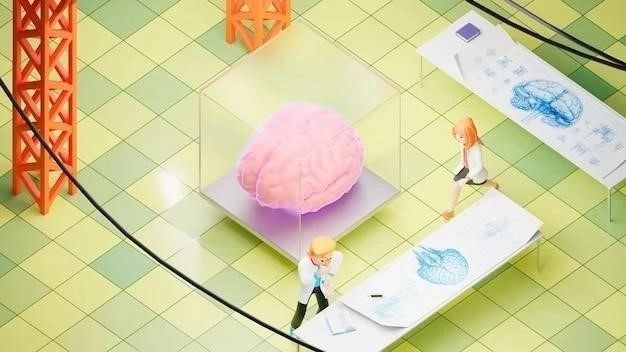The Science of Addiction: Understanding the Brains Reward System
Addiction, often misunderstood as a moral failing or a lack of willpower, is a complex chronic disease deeply rooted in the intricate workings of the brain․ Its characterized by compulsive engagement in rewarding stimuli, despite adverse consequences․ This article delves into the neuroscience behind addiction, focusing on the brains reward system and how its manipulation by addictive substances leads to the development and maintenance of this challenging condition․
The Brains Reward System: A Delicate Balance
At the core of addiction lies the brains reward system, a complex network of neural pathways responsible for driving life-sustaining behaviors like eating, drinking, and social interaction․ When we engage in these activities, the reward system is activated, releasing a surge of dopamine, a neurotransmitter associated with pleasure, motivation, and reinforcement․ This dopamine release creates a sense of satisfaction and reinforces the behavior, increasing the likelihood of its repetition․
Key components of the reward system include:
- Ventral Tegmental Area (VTA): Located in the midbrain, the VTA is the primary source of dopamine and plays a crucial role in initiating reward signals․
- Nucleus Accumbens (NAc): This region, situated in the basal forebrain, receives dopamine signals from the VTA and plays a vital role in experiencing pleasure and motivation․
- Prefrontal Cortex (PFC): This frontal lobe region is crucial for executive functions like decision-making, planning, and impulse control․ The PFC receives input from the reward system and helps regulate our responses to rewarding stimuli․
Hijacking the System: How Addiction Takes Hold
Addictive substances, whether they be drugs or alcohol, disrupt the delicate balance of the brains reward system․ These substances achieve this by:
1․ Flooding the System: Drugs like cocaine and methamphetamine directly increase dopamine levels in the NAc, creating an intense and amplified sense of euphoria far surpassing natural rewards․
2․ Altering Dopamine Signaling: Opioids, such as heroin and prescription painkillers, bind to opioid receptors in the VTA and NAc, inhibiting GABAergic neurons that normally regulate dopamine release․ This disinhibition leads to an excessive surge of dopamine․
3․ Mimicking Natural Rewards: Nicotine, found in tobacco products, binds to nicotinic acetylcholine receptors in the VTA, stimulating dopamine release and mimicking the effects of acetylcholine, a neurotransmitter involved in reward and learning․
From Pleasure to Compulsion: The Cycle of Addiction
The initial pleasurable effects of addictive substances are potent reinforcers, encouraging repeated use․ However, as the brain adapts to the continuous presence of these substances, several changes occur:
- Tolerance: The brain becomes less sensitive to the effects of the substance, requiring larger doses to achieve the same level of reward․
- Dependence: The body and brain become physically dependent on the substance to function normally․ Withdrawal symptoms occur upon cessation of use, further fueling the addiction cycle․
- Craving: Intense cravings for the substance develop, driven by changes in the brains reward system and conditioned learning, where environmental cues become associated with drug use․
- Loss of Control: The PFC, responsible for executive control, is significantly impacted by chronic substance use․ This impairment weakens decision-making, impulse control, and the ability to resist cravings․

Beyond Dopamine: The Role of Other Neurotransmitters
While dopamine plays a central role in addiction, other neurotransmitters are also involved in the development and maintenance of this complex disorder:
- Glutamate: This excitatory neurotransmitter plays a crucial role in learning and memory․ In the context of addiction, glutamate strengthens the connections between rewarding experiences and drug-related cues, contributing to cravings and relapse․
- GABA: As the primary inhibitory neurotransmitter, GABA helps regulate anxiety and stress․ Chronic substance use disrupts GABAergic signaling, leading to increased anxiety, irritability, and difficulty coping with stress, further perpetuating the addiction cycle․
The Path to Recovery: Rewiring the Brain
Recovery from addiction is a challenging but achievable journey․ Just as chronic substance use alters brain structure and function, abstinence and treatment can help restore balance to the reward system and other affected brain regions․
Effective treatment approaches often involve a multifaceted approach, including:
- Behavioral Therapies: Cognitive Behavioral Therapy (CBT) and Contingency Management (CM) help individuals identify and modify maladaptive thoughts and behaviors associated with drug use․
- Medications: Medications such as methadone, buprenorphine, and naltrexone can help reduce cravings, manage withdrawal symptoms, and prevent relapse․
- Support Groups: 12-step programs like Narcotics Anonymous (NA) and Alcoholics Anonymous (AA) provide a supportive community and structure for individuals in recovery․

Conclusion
Addiction is not a character flaw but a complex brain disease that requires comprehensive treatment and long-term management․ Understanding the neuroscience behind addiction, particularly the hijacking of the brains reward system, is crucial for developing effective prevention strategies, reducing stigma, and improving treatment outcomes for individuals struggling with this challenging disorder․
The Impact of Addiction on Brain Structure and Function
Chronic substance abuse casts a long shadow, altering not only the reward systems delicate balance but also impacting other brain regions crucial for executive function, emotional regulation, and learning․ These profound neurobiological changes contribute to the chronic, relapsing nature of addiction․
Prefrontal Cortex: Decision-Making Under Siege
The prefrontal cortex (PFC), responsible for executive functions such as planning, decision-making, and impulse control, suffers significant impairment due to chronic substance use․ Addictive substances disrupt the PFCs intricate neural circuitry, weakening its ability to exert control over impulsive behaviors and make rational choices, even in the face of negative consequences․ This diminished executive function contributes to the cycle of craving, drug-seeking, and relapse that characterizes addiction․
Hippocampus: Memories Painted with Substance
The hippocampus, nestled deep within the brain, plays a critical role in memory formation and retrieval․ In the context of addiction, the hippocampus forms strong associations between the pleasurable effects of drugs and the people, places, and objects present during drug use․ These powerful memories, often triggered by environmental cues, can ignite intense cravings and increase the likelihood of relapse, even after prolonged periods of abstinence․
Amygdala: Trapped in a Cycle of Stress and Addiction
The amygdala, the brains emotional processing center, plays a crucial role in fear, anxiety, and stress responses․ Chronic substance use disrupts the amygdalas delicate balance, leading to heightened anxiety, irritability, and a diminished ability to cope with stress․ This dysregulation of the amygdala contributes to the negative emotional state experienced during withdrawal, driving individuals to seek relief through further substance use, thereby perpetuating the vicious cycle of addiction․
Genetic and Environmental Factors: A Complex Interplay
While the neurobiological underpinnings of addiction are undeniable, it is crucial to acknowledge the significant role played by genetic and environmental factors in shaping an individuals vulnerability to developing this complex disorder․
Genetic Predisposition: A Blueprint for Risk
Research suggests that genetic factors account for approximately 40-60% of an individuals susceptibility to addiction․ Variations in genes related to dopamine transmission٫ drug metabolism٫ and reward sensitivity can influence an individuals initial response to drugs٫ their propensity for developing tolerance and dependence٫ and their overall risk for developing addiction․
Environmental Influences: Shaping Vulnerability
Environmental factors, encompassing a wide range of social, cultural, and personal experiences, play a critical role in shaping an individuals vulnerability to addiction․ Early life adversity, such as childhood trauma or neglect, can have lasting impacts on brain development and increase the risk of substance abuse later in life․ Additionally, exposure to substance use within the family or peer group, social isolation, and cultural norms surrounding drug use can significantly influence an individuals likelihood of engaging in and developing problems with addictive substances․

Conclusion: A Call for Comprehensive Understanding and Treatment
Addressing the complex challenge of addiction requires a multifaceted approach that acknowledges the intricate interplay of neurobiological, genetic, and environmental factors․ Recognizing addiction as a chronic, relapsing brain disease, rather than a moral failing, is crucial for reducing stigma and fostering a compassionate and supportive environment for recovery․ Combining pharmacological interventions with evidence-based behavioral therapies, personalized counseling, and strong social support systems offers the most promising pathway to helping individuals break free from the clutches of addiction and reclaim control of their lives․
The Neurobiology of Craving and Relapse
Understanding the persistent grip of addiction necessitates delving deeper into the neurobiological mechanisms underlying craving and relapse․ Even after significant periods of abstinence, individuals may experience intense cravings triggered by environmental cues, stressful life events, or even seemingly innocuous encounters with people or places associated with past drug use․ These cravings often lead to relapse, highlighting the formidable challenges faced by those in recovery․
Conditioned Cues: Hijacking the Reward Pathway
Repeated substance use creates powerful associations between the rewarding effects of drugs and the environmental cues present during drug use․ This process, known as classical conditioning, leads to the development of conditioned cues – sights, smells, sounds, or even emotions – that become inextricably linked to the anticipated reward of the drug․ Exposure to these conditioned cues can trigger intense cravings and physiological responses, such as increased heart rate and sweating, mimicking the bodys anticipation of the drug itself․
Stress: A Relapse Vulnerability Factor
Stress, a ubiquitous aspect of modern life, plays a significant role in relapse vulnerability․ Chronic substance use disrupts the bodys stress response system, leading to heightened sensitivity to stress and an impaired ability to cope with challenging life events․ When confronted with stressors, individuals in recovery may experience intense cravings and turn to drug use as a maladaptive coping mechanism, seeking to alleviate their discomfort and regain a sense of control․
Weakened Executive Control: A Battle Against Impulsivity
As previously discussed, chronic substance use weakens the prefrontal cortex, the brain region responsible for executive functions such as decision-making, impulse control, and long-term planning․ This impairment in executive control makes it challenging for individuals in recovery to resist cravings, especially when confronted with drug-related cues or stressful situations․ The weakened prefrontal cortex struggles to override the impulsive, reward-seeking urges driven by the more primitive brain regions, increasing the likelihood of relapse․
Emerging Treatment Strategies: Tailoring Interventions to Individual Needs
Addressing the complex neurobiological underpinnings of craving and relapse requires innovative treatment strategies that go beyond traditional approaches․ Emerging research focuses on developing personalized interventions tailored to an individuals unique genetic makeup, environmental risk factors, and specific addiction-related brain changes․
Pharmacological Interventions: Targeting Neurotransmitter Imbalances
Medications targeting specific neurotransmitter systems involved in reward, craving, and stress response show promise in reducing relapse rates․ For example, medications that modulate glutamate activity may help weaken the strength of drug-related memories and reduce cue-induced cravings․ Similarly, medications that enhance GABAergic signaling can help alleviate anxiety and improve stress resilience, mitigating a significant relapse vulnerability factor․
Neuromodulatory Techniques: Fine-Tuning Brain Circuits
Non-invasive brain stimulation techniques, such as transcranial magnetic stimulation (TMS) and transcranial direct current stimulation (tDCS), offer targeted approaches to modulating brain activity in regions implicated in addiction․ By delivering precisely targeted magnetic or electrical pulses, these techniques can either enhance or inhibit activity in specific brain circuits, potentially weakening drug-related memories, reducing cravings, and strengthening executive control․
Mindfulness-Based Interventions: Cultivating Awareness and Self-Regulation
Mindfulness-based interventions, such as Mindfulness-Based Relapse Prevention (MBRP), empower individuals in recovery to develop a non-judgmental awareness of their thoughts, feelings, and bodily sensations․ By cultivating this heightened awareness, individuals can learn to identify cravings early on, observe them without judgment, and develop healthier coping mechanisms to ride out the craving without resorting to drug use․
Conclusion: A Future of Hope and Innovation
As our understanding of the neurobiological underpinnings of addiction deepens, so too does our capacity to develop more effective, personalized treatment strategies․ By targeting the specific brain circuits and neurotransmitter systems disrupted by chronic substance use, emerging interventions offer renewed hope for individuals struggling with addiction․ Combining these innovative approaches with traditional behavioral therapies, strong social support systems, and a compassionate approach to recovery promises a brighter future for individuals and families impacted by this challenging disorder․










